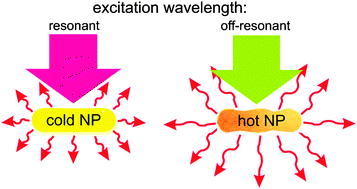The photothermal (PT) outputs of individual gold nanoparticles (NP) were compared at room (cold) and high transient (hot) temperatures. High temperatures were induced in NPs by a single 0.5 ns laser pulse. All NPs with near-infrared plasmon resonances (rods, shells and bi-pyramids) exhibited a significant decrease in their photothermal output at the resonant wavelengths under high temperature, while non-resonant excitation of the same NPs provided several times higher PT efficacy of the hot NPs. This “inversion” of the PT efficacy of hot plasmonic NPs near their plasmon resonances might have been caused by damping of their resonances due to heating and surface melting. Therefore, photothermal output of plasmonic nanoparticles significantly depends upon their thermal state including the shift in excitation wavelength in hot nanoparticles. In particular, NPs with near-infrared resonances perform several times more efficiently at non-resonant excitation wavelengths rather than at the resonant ones.

